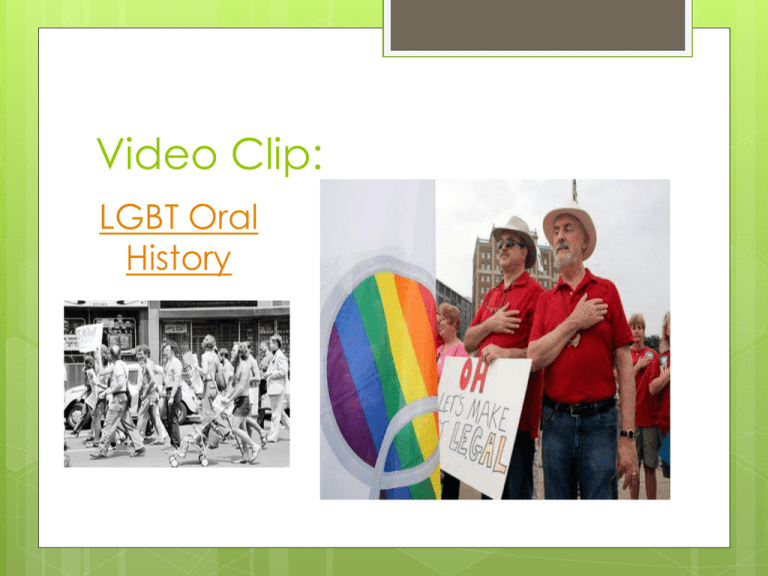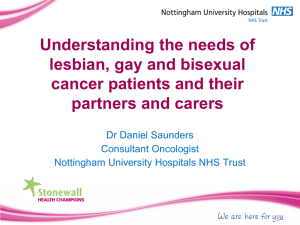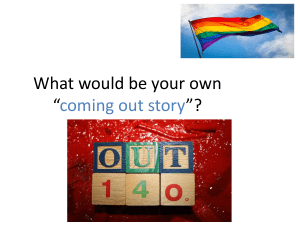
Video Clip:
LGBT Oral
History
Sunrise and Sunset
of the LGBT Aging
Community
Grace Hoyer, EdD, MSN, RN
Assistant Professor
Grand Valley State University
Kirkhof College of Nursing
Objectives
To raise awareness of
potential discrimination
against LGBT seniors
To stimulate greater cultural
competence in senior care
institutions through education
To facilitate the awareness of
history and resilience of
individuals within the older
LGBT community.
To promote discussion related
to strategies to bridge gaps
for LGBT older adults in the
West Michigan environment
How Many Americans Identify as LGBT?
It
is estimated that more than 2.4 million
adults ages 50 and older in the US identify
as lesbian, gay, bisexual, or transgender
(LGBT), accounting for 2.4% of the
population (Fredriksen-Goldsen,2015).
As Baby Boomers age (1946-1964) increasing numbers
of older adults will openly identify as LGBT
The MetLife Study of LGBT Baby Boomers,
Percentage of respondents who are
completely or mostly “out”
Lesbian
76%
Gay
74%
Bisexual
16%
Transgender
39%
6
Experiences of Discrimination Over a Lifetime
1952
1962
1969
1980s
1993
2008
• The American Psychiatric
Association lists
homosexuality as a mental
disorder. It would be
removed 20 years later in
the DSM IV, 61 years until
transgender is removed.
• The AIDS crisis galvanized
the LGBT community, but
also showed lack of
governmental action to
protect LGBT individuals
health.
• The “Moral Majority”starts
crusade against LGBT
community.
• Illinois becomes the first
state to decriminalize
private, consensual
homosexual acts. Until then,
sodomy could be punished
by lengthy terms of
imprisonment of hard labor
• President Clinton
implements the “Don’t Ask,
Don’t Tell” policy prohibiting
LGBT service men and
women from serving openly
in the military. The policy
was repealed in 2010.
• Patrons of the Stonewall Inn
respond to a police raid with
a violent riot, inciting a series
of protests and sparking the
modern gay civil rights
movement.
• Californians pass a state
constitutional amendment
banning gay marriage after
the state supreme court had
ruled previous bans as
unconstitutional. The
Supreme Court ruled the
amendment unconstitutional
in 2013.
Improving the Lives of
LGBT Older Adults: Policy
Report (March, 2010)
The
LGBT older adult population will double by
2030
This
population has a history of making social
changes, therefore they are more likely to assert
their rights as older LGBT Americans
Haber, 2009
8
Medicare Offers Benefits, Joint
Placement to LGBT Seniors
In September 2013, HHS
announced
legally married same-sex couples
on Medicare will be eligible for
equal benefits
joint placement in nursing homes
around the country
Medicare applies equally to all
married couples
Must allow patients to decide
who has visitation rights and who
can make medical decisions for
them, regardless of sexual
orientation, gender identity or
family makeup
Challenges & Opportunities: General
Michigan LGBT older adults
face additional and sometimes
extreme barriers to resources
and care.
90% LGBT older adults have no
children to help care for them
(compared to 20% of
heterosexual older adults)
Twice as many LGBT older
adults live alone as compared
to heterosexual older adults.
LGBT older adults are nearly 3
times as likely to live in poverty
as heterosexual adults.
Summit for LGBT older adults coming. (2012, Jun 14).
Between the Lines. Retrieved from
http://search.proquest.com.ezproxy.gvsu.edu/doc
view/1023800613?accountid=39473
Challenges & Opportunities: Invisibility
LGBT older adults have been largely invisible
within health and aging services research,
despite being disproportionately burdened by
poor health and aging outcomes (Cloyes,
2015).
Psychotherapy with LGBT older adults has not
received enough attention in research and
literature (Baron & Cramer, 2000)
LGBT seniors are only 20% as likely as
heterosexuals elder to access needed
services (Haber, 2009)
Challenges & Opportunities:
Older LGBT Michiganders
Federal
and state civil rights laws do not
include the terms sexual orientation and
gender identity, and therefore do not
protect these individuals.
Due to the lack of a concrete policy,
aging providers are not required to go
through cultural competency training.
Challenges & Opportunities: Housing
34 % 127 participants said they
thought hiding their sexual identity
would be necessary if they moved
to a retirement home
Johnson(2005)
One half of senior centers do not
welcome gay men and lesbians
who are open about their sexual
orientation (Knauer, 2009).
Gay elders are likely to be rejected
by retirement communities and
nursing homes (Haber, 2009)
Strong initiative for LGBT specific
housing
13
Challenges & Opportunities: Older
Transgender Adults Health Concerns
Less likely to receive preventive care:
Examples: Breast cancer screening and cervical cancer
screening needed in Trans Men (female to male
transgender); prostate screening needed in Trans Women
(male to female transgender)
Underscores why it is important to learn about both gender
identity, sex assigned at birth, and current anatomy.
Long-term effects of hormone therapy should be
monitored
Higher risk for HIV in trans women, and risk of STI’s
based on behavior
12% of trans women and 1% of trans men transition
after age 55
Cahill et al, 2000
14
Challenges & Opportunities: Financial
9.10
%
4.60
%
4.90
%
Higher
poverty in
lesbian couples
Lack of benefits for
spouses in
unmarried couples
Senior
Senior
Senior
Straight
Gay
Lesbian
Couples Couples Couples
Goldberg, NG., The Williams Institute, 2009
Gender Identity Experiences Related to Resident’s Real or Perceived
Number of Percent of Sexual Orientation and/or Gender Identity
Number of
Instances
Percentages
of All
Instances
Verbal or Physical Harassment From Other Residents
200
23%
Refused Admission or Re-admission, Attempted or Abrupt
Discharge
169
20%
Verbal or Physical Harassment From Staff
116
14%
Staff Refused to Accept Medical Power of Attorney from
Resident’s Spouse or Partner
97
11%
Restriction of Visitors
93
11%
Staff Refused to Refer to Transgender Resident by Preferred
Name or Pronoun
80
9%
Staff Refused to Provide Basic Services or Care
51
6%
Staff Denied Medical Treatment
47
6%
Total
853
100%
Quotes
I’ve not known anyone in a facility who has stated their
alternative sexual orientation, which says a lot in itself.
Most feel that there are no LGBT residents in their facilities.
A gay couple moved into my mother’s facility. The residents
kept talking about: “Which one is the man and which one is the
woman?” They moved out in a couple of months.”
Several residents’ offhand comments about gays and fags
make me (and any gays) uncomfortable.
My partner was in the long-term skilled nursing facility for 30
days— it was a difficult time for both of us, but particularly
because of some staff who seemed to “resent” our relationship
and my advocacy on his behalf.
I have been haunted for years by what happened to two
lesbian friends of mine. They had been “married” for more than
50 years, when they both fell ill. Their families sent them to
separate nursing facilities despite all protests. They each shortly
passed away. It was heartbreaking
19
Health Disparities & LGBT Elders
Bias in Health
Care
Stigma and
Discrimination
Social
Determinants
Health Care
Disparities
Adapted from IOM 2011:The Health of Lesbian,
Gay, Bisexual and Transgender People
Enhancing Resilience
Learn
to cope with stigma from an early
age
Role flexibility
Ability to cope with crises
Importance of social support in successful
aging: social support from other LGBT
members is crucial in healthy aging
Berger, 1982
21
Enhancing Resilience
91% engage in wellness activities
89% feel good about belonging to the LGBT
community
71% percent reported having a person in their life
to love and make them feel wanted
83% have people with whom to do something
enjoyable
The Aging and
Health Report
Role of Sex & Sexuality
Sexuality
Gendered stereotypes focus on asexuality or an
overdeveloped interest in sex
postmenopausal woman may be seen as frigid
“dirty old man”
“Greater sexual freedom" among baby boomers
(Jacoby 2005).
maintaining sexual activity throughout the lifespan
overcoming the physical limitations
Culturally sensitive counseling
How we view ourselves as sexual beings
Ways we reveal ourselves physically, emotionally,
and psychologically.
23
Encourage Advance Planning
Living will
Health care power of attorney/proxy
Provides instruction if person is incapacitated
Allows the individual to designate a surrogate
decision maker
Often combined into an “Advance Directive”
Very important for same-sex couples,
especially those who are unable to marry
Advance Directives Resources:
http://www.hrc.org/resources/entry/protecting-yourvisitation-decision-making-rights
LGBT Older Adults in Long-Term Care
Facilities, Supportive Organizations
National Senior Citizens Law Center
National Gay and Lesbian Task Force
Services & Advocacy for GLBT Elders (SAGE)
Lambda Legal
National Center for Lesbian Rights
National Center for Transgender Equality
National Council on Aging
AARP
Family Caregivers Alliance
Old Lesbians Organizing for Change
Organizations
26
Be Aware
Be Open
Be Knowledgeable
Poem:
Piecing the
Quilt
Lawrence
Johnson
Gay
African
Poet
American
Resources
Services and Advocacy for Gay Elders
(SAGE):http://sageusa.org/about/
American Society on Aging (ASA)
The LGBT Aging Issues Network (LAIN)
LGBT older adults in Long term care facilities:
http://www.lgbtlongtermcare.org
Gay and Lesbian Medical Association
American Society on Aging
www.asaging.org
National Gay and Lesbian Task Force
www.glma.org
www.thetaskforce.org
Improving the Lives of LGBT Older Adults, March 2010
http://www.lgbtmap.org/file/improving-the-lives-oflgbt-older-adults.pdf
Haber, 2009
References
Addis S, Davies M, Greene G, Macbride-Stewart S, Shepherd M. The health, social care and housing needs of lesbian,
gay, bisexual and transgender older people: a review of the literature. Health Soc Care Community. 2009;17(6):647658.
Arien, K. M., & Adeyinka, M. A. (2013). Older adults and sexuality: Implications for counseling ethnic and sexual
minority clients. Journal of Mental Health Counseling, 35(1), 1-14. Retrieved from
http://search.proquest.com.ezproxy.gvsu.edu/docview/1269701620?accountid=39473
Baron, A., & Cramer, D. (2000). Potential Counseling Concerns Of Aging Lesbian, Gay, And Bisexual Clients. In R. M.
Perez., K. A. Debord., K. J. Bieschke (Eds.), Handbook of counseling and psychotherapy with lesbian, gay, and
bisexual clients (pp. 207-223). Washington, DC: American Psychological Association, 2000.
Berger, R. M. (1982)."The Unseen Minority: Older Gays and Lesbians. Social Work,27(3),236-242. Retrieved from
http://web.ebscohost.com/ehost/resultsadvanced?sid=f8029f21-5b85-4031Brennan-Ing, M., Seidel, L., Larson, B., & Karpiak, S. E. (2014). Social care networks and older LGBT adults: Challenges
for the future. Journal of Homosexuality, 61(1), 21-52. doi:10.1080/00918369.2013.835235
Claes JA, Moore W. Issues confronting lesbian and gay elders: the challenge for health and human services providers.
J Health Hum Serv Adm. 2000;23:181-202
Haber, D. (2009) Gay Aging. Gerontology & Geriatrics Education 30 (3) 267-80. doi:10.1080/02701960903133554
References
Cloyes, K. G. (2015). The silence of our science: Nursing research on LGBT older adult
health. Research in Gerontological Nursing, , 1-13. doi:http://dx.doi.org/10.3928/1940492120151218-02
David, S., & Cernin, P.A. (2008) Psychotherapy with Lesbian, Gay, Bisexual, and Transgender Older
Adults. Journal of Gay & Lesbian Social Services 20(1), 31-49. doi:10.1080/10538720802178908
Fredriksen-Goldsen, K.I., Kim, H., Murac,,A., & Mincer, S. (2009). Chronically Ill Midlife and Older
Lesbians, Gay Men, and Bisexuals and Their Informal Caregivers: The Impact of the Social
Context." Sexuality Research and Social Policy: Journal of NSRC 6 (4), 52-64. Retrieved from
http://web.ebscohost.com/ehost/resultsadvanced?sid=f8029f21-5b85-4031-bab5
Grant, J.M. (2010). Outing Age 2010: Public Policy Issues Affecting Lesbian, Gay, Bisexual and
Transgender Elders. Retrieved from National Gay and Lesbian Task Force website:
http://www.thetaskforce.org/reports_and_research/outing_age_2010
Jacoby, S. (2005, July & August). Sex in America. AARP: The Magazine. Retrieved from
http://www.aarpmagazine.org/lifestyle/relationships/sex_in_america.html/



